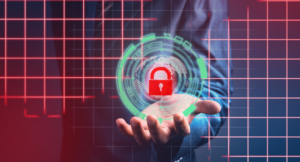2024 was a whirlwind year for cybersecurity, with unprecedented breaches, evolving attack tactics, and critical lessons for businesses to take into 2025. As we prepare for the challenges ahead, let’s reflect on the biggest cybersecurity stories of 2024 and the trends shaping the future of digital security.

Cybersecurity Case Studies: Key Incidents from 2024
Russia’s Midnight Blizzard’s Persistent Threats
What Happened:
In January, Russian-backed hacking group Midnight Blizzard infiltrated Microsoft’s corporate systems, exploiting a legacy account with weak security. Through password spraying—a brute force method of trying common passwords—the group accessed emails and internal documents.
Why It Matters:
Even tech giants like Microsoft aren’t immune to vulnerabilities. The attack highlights the importance of eliminating outdated accounts and implementing multi-factor authentication (MFA) for all users.
Record-Setting Ransomware Payments
What Happened:
Global ransomware payments hit a staggering $1 billion in 2023, with this trend continuing into 2024. “Big game hunting” tactics, where attackers target large organizations for multimillion-dollar payouts, became more frequent.
Why It Matters:
As ransomware groups grow more aggressive, businesses of all sizes need to prioritize incident response planning, backup strategies, and employee training to resist paying ransoms.
Russia’s Midnight Blizzard’s Persistent Threats
What Happened:
In January, Russian-backed hacking group Midnight Blizzard infiltrated Microsoft’s corporate systems, exploiting a legacy account with weak security. Through password spraying—a brute force method of trying common passwords—the group accessed emails and internal documents.
Why It Matters:
Even tech giants like Microsoft aren’t immune to vulnerabilities. The attack highlights the importance of eliminating outdated accounts and implementing multi-factor authentication (MFA) for all users.
RockYou 2024: The Largest Password Dump Ever
What Happened:
In July, nearly 10 billion passwords were leaked in the largest password compilation ever—dubbed “RockYou2024.” This massive data dump included entries from previous breaches, offering attackers an easy way to target individuals and organizations.
Why It Matters:
This incident underscores the urgency of using strong, unique passwords and adopting password managers to reduce vulnerability.
The AT&T Data Breach
What Happened:
AT&T revealed that nearly all of its customer call and text records from May to October 2022 were compromised and exfiltrated by threat actors in April 2024. The breach occurred via a vulnerability in third-party data storage systems.
Why It Matters:
Third-party risks are a growing concern. Businesses must ensure their partners and vendors meet rigorous security standards to prevent cascading breaches.
CrowdStrike Update Causes Global IT Outage
What Happened:
A faulty update from cybersecurity firm CrowdStrike in July caused 8.5 million Windows devices worldwide to crash, disrupting emergency services and critical infrastructure.
Why It Matters:
This incident highlights the risks tied to over-reliance on updates and automation. Testing patches and updates in controlled environments is essential to avoid widespread disruptions.
National Public Data Breach: 2.7 Billion Records Exposed
What Happened:
In August, a breach at National Public Data leaked nearly 3 billion records, including sensitive data like Social Security numbers. The incident became one of the largest data breaches in history.
Why It Matters:
Massive breaches like this emphasize the need for encryption, regular audits, and robust security protocols to protect personally identifiable information (PII).
Internet Archive Data Breach
What Happened:
In October, the Internet Archive suffered a breach exposing data from over 31 million users. The attack also coincided with three DDoS assaults orchestrated by hacktivist group BlackMeta.
Why It Matters:
Non-profits and public service platforms are increasingly being targeted. Organizations in this space must prioritize cybersecurity despite limited budgets.
Largest Health Data Breach in U.S. History
What Happened:
Threat actors breached Change Healthcare’s systems in February, exposing private health information for over 100 million people. The attack delayed prescription deliveries and caused over $700 million in business losses.
Why It Matters:
The healthcare sector continues to be a top target for cybercriminals. Implementing sector-specific security measures, like HIPAA compliance, is critical for minimizing risk.
Emerging Trends in Cybersecurity for 2025
As we move into 2025, several key trends are set to shape the cybersecurity landscape:
- AI-Driven Defense Mechanisms: Artificial intelligence will be integral to combating increasingly sophisticated cyber threats. AI can analyze vast amounts of data in real time, identifying vulnerabilities and mitigating risks faster than ever before.
- Rise of Zero Trust Architecture: More organizations are adopting zero trust models, where trust is never assumed, and every user and device must be continuously verified. This approach will help prevent unauthorized access and lateral movement within networks.
- Quantum Computing Threats: With quantum computing on the horizon, encryption methods could become obsolete. In 2025, expect increased focus on post-quantum cryptography to prepare for this emerging risk.
- Regulatory Scrutiny on Data Privacy: Governments worldwide are tightening regulations on how businesses handle user data. Compliance will be critical to avoid hefty fines and maintain customer trust.
- Growing Importance of Cyber Resilience: Resilience will go beyond prevention, focusing on how quickly businesses can recover from an attack. Incident response plans, disaster recovery systems, and cyber insurance will be at the forefront of business strategies.
Lessons from 2024’s Biggest Cybersecurity Threats
The events of 2024 revealed weaknesses in even the most secure systems and highlighted the importance of proactive, adaptive cybersecurity strategies. Here are some of the key takeaways:
- Multi-Factor Authentication is Non-Negotiable: Attacks like Midnight Blizzard’s assault on Microsoft showed how a lack of MFA allowed adversaries to breach systems with ease. Businesses must treat MFA as a baseline, not an option.
- AI’s Role in Ransomware: As ransomware attacks became more frequent and complex, AI tools played a dual role: empowering attackers and enabling defenders to automate threat detection and response.
- Data Breaches Can Be Devastating: The exposure of nearly all AT&T customer phone records and the largest-ever healthcare breach in the U.S. illustrated the need for robust data encryption and vendor risk management to protect sensitive information.
These incidents underscore the necessity of continuous monitoring, employee training, and embracing a security-first mindset. Cybersecurity in 2025 will demand heightened vigilance and smarter defensive strategies.
At GreenBean IT, we’re committed to helping businesses stay secure in an ever-changing digital landscape. Contact us today to learn how we can strengthen your cybersecurity defenses for 2025.
